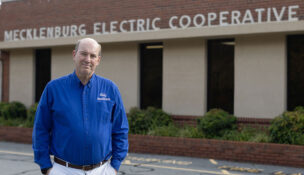‘Where the game is happening’
Region aims to become East Coast offshore wind hub
‘Where the game is happening’
Region aims to become East Coast offshore wind hub
Touting one of North America’s largest ports, congestion-free shipping channels and the nation’s highest percentage of maritime workers, Hampton Roads is charting a course to become the East Coast supply chain hub for the offshore wind industry.
Those attributes, say local leaders, set the region apart in the race to build the nascent carbon-neutral energy sector. The U.S. Department of Energy estimates that offshore wind farms under development off the East Coast will support up to 86,000 jobs and provide up to $25 billion in economic output by 2030.
Currently, the projects rely on a European supply chain for their massive turbines, blades, generators and foundations, but shipping those mechanisms overseas to the United States is expensive, time-consuming and risky. That’s why East Coast states are eager to cut out the middleman by manufacturing the components in the U.S. and delivering them to offshore wind projects along the Atlantic seaboard.
Hampton Roads’ deep, wide harbor, free of air-draft restrictions posed by bridges and other overhead structures, combined with its abundance of terminal facilities and waterfront industrial sites, as well as a large workforce skilled in shipbuilding and ship repair, give the region strong selling points for enticing companies involved in manufacturing, installing and maintaining offshore wind components. Plus, the state offers pro-business incentives such as lower taxes and labor costs and fewer regulations.
“Right now, the industry is being born in the U.S., and all states that have [offshore wind] projects have ambitions to gain economically,” says Matt Smith, director of offshore wind business development for the Hampton Roads Alliance. “We have a lot of advantages in Hampton Roads with the port structure and workforce, but we have to compete to have offshore wind become the fourth pillar of [the region’s] economy,” after the military, the Port of Virginia and tourism.
According to an economic impact analysis by Glen Allen-based Mangum Economics, the East Coast offshore wind industry would support approximately 5,200 Virginia-based jobs — primarily in Hampton Roads — as businesses help develop one gigawatt of new offshore wind energy generation annually. Cultivating offshore wind at that pace would generate $270 million in pay and benefits, as well as $740 million in regional economic impact, including $21 million in local government revenue for Hampton Roads and $18 million in Virginia state tax revenue.
Center stage
Many of those benefits will be derived from Dominion Energy Inc.’s planned 2.6-gigawatt, $7.8 billion Coastal Virginia Offshore Wind project. Slated for completion in 2026, the offshore wind farm will include about 180 massive wind turbines erected in federal waters 27 miles off the Virginia Beach coast. About 900 jobs will be created during construction and 1,100 for operations and maintenance during the project’s approximately 30-year lifespan. That could lead to roughly $210 million in local economic impact.
In addition, Hampton Roads is poised to support development of Avangrid Renewables’ 2,500-megawatt project off the coast of Kitty Hawk, North Carolina. That project is expected to produce more than 800 jobs, with a $2 billion impact on Virginia and North Carolina economies over the next decade.
About 625 job titles exist in the offshore wind industry, with more than 120 unique to the field, says Shawn Avery, president and CEO of the Hampton Roads Workforce Council. “It’s all [skill] levels, from high school graduates to community college and four-year graduates. It really does run the gamut,” he says.
Engineers and scientists, along with skilled tradespeople like welders and electricians, will be needed to support offshore wind farms.
About 90% of the skills required in the offshore wind industry match those in other local maritime industries. “Hampton Roads is built on those skill sets,” Avery says. “We’ve got a lot of assets to make us the prime location for the offshore-wind supply chain hub.”
Earlier this year, the state launched the Mid-Atlantic Training Alliance at Virginia Beach’s Centura College, the Mid-Atlantic Maritime Academy and Martinsville’s New College Institute, all of which will provide wind-related training courses certified by the Global Wind Organisation. Community colleges and universities also offer similar training opportunities.
Last year, Virginia, North Carolina and Maryland formed a partnership to promote the Southeast and mid-Atlantic as the hub for offshore wind’s supply chain. “Each state plays on each other’s strengths and works together so companies see us as a group of states that provide a cross section of strengths,” Smith says. “That makes us more competitive as a whole.”
With a satellite office in Germany, the Hampton Roads Alliance markets Hampton Roads’ assets to European companies considering manufacturing wind turbines and blades in the U.S. “We have a very robust business attraction,” Smith says. “We make sure companies understand our strengths as a region and can position themselves to be part of the supply chain.”
Smith notes that a study prepared earlier this year for the North Carolina Department of Commerce gave high marks to Portsmouth Marine Terminal and Lambert’s Point Docks Inc. for their readiness to support offshore wind manufacturing. Denmark renewable energy company Ørsted is already leasing part of Portsmouth Marine Terminal from the Port of Virginia to stage materials and equipment for its offshore wind projects in six states. And in August, Dominion reached an agreement with the port to lease part of Portsmouth Marine Terminal as a staging and pre-assembly area for the turbines needed for its Coastal Virginia Offshore Wind project.
Wind trade
Hampton Roads is also looking to capitalize on homeporting Dominion’s $500 million, 472-foot wind component installation vessel, Charybdis. Currently under construction in Brownsville, Texas, the ship is expected to enter service in 2023, when it will transport materials to two offshore wind farms under construction in New England. Charybdis is the nation’s first offshore wind vessel in compliance with the Jones Act, which requires goods shipped between U.S. ports to be carried on American-built ships. “Being the homeport for the U.S.’s only wind turbine installation vessel is just one thing that can help us become the center of gravity for the industry,” Smith says.
With tremendous economic benefits on the line, the next three years are critical to attract companies and develop the region as a supply chain hub, says Robert Crum, executive director of the Hampton Roads Planning District Commission.
This summer, the HRPDC board approved a resolution encouraging the General Assembly to create a $30 million economic development fund to help companies offset expenses for worker training and certifications, new product development and equipment upgrades. “Sometimes the process for businesses to migrate to supporting the supply chain costs money and is time-consuming,” Crum notes. “We think this fund will help companies offset costs.”
Companies checking out Hampton Roads’ offshore wind industry have an entry point into the region through the Virginia Offshore Wind Landing, a workspace in downtown Norfolk for maritime and offshore wind companies interested in establishing a presence in Hampton Roads to collaborate and access resources. The space is a partnership between Virginia Energy (formerly the Virginia Department of Mines, Minerals, and Energy); the Hampton Roads Alliance; and Old Dominion University’s OpenSeas Technology Innovation Hub.
“It’s a very convenient setup,” says Nancy Grden, executive director of ODU’s Hampton Roads Maritime Collaborative for Growth & Innovation. “Interested companies can come together and learn about what’s available here.”
Jerry Cronin, executive director of the OpenSeas tech hub, agrees, saying, “If we do our job right, we will see the growth of new companies, and existing companies will create new lines of business and attract new companies.” Formed to address challenges and opportunities in the maritime industry, the hub will help firms commercialize offshore wind innovations.
“There are broader implications,” he adds. “Something done with offshore wind could be useful for the ports or the Navy. Hampton Roads is where the game is happening.”
l
















